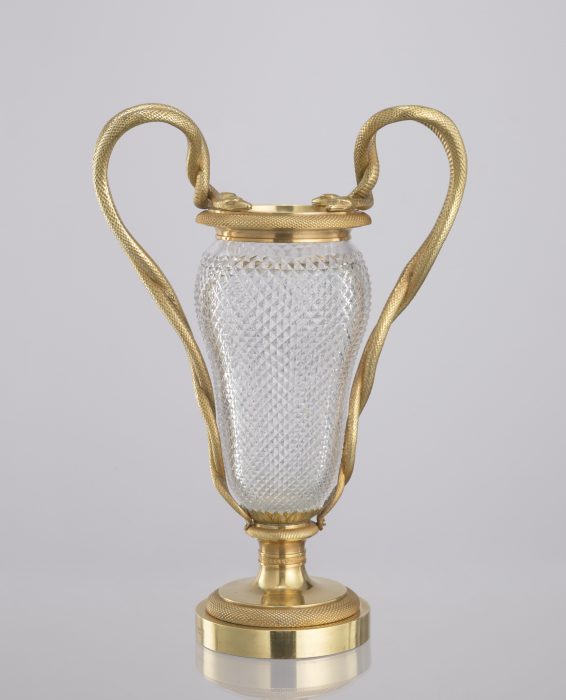
Vaze with snake motifs
The vase was created in the workshop of the Łopieński Brothers around 1890. Its extraordinary belly, made of glass decorated with diamond cut, was framed with gilded bronze.
Products of lead glass decorated with diamond cut originated from England and Ireland. The English were able to carry out deep cuts in heavy thick glass. However, a tax on the weight of glass, imposed in 1746, reduced the profitability of working in this massive material. In turn, the right to pursue free trade activities won by the Irish in 1780 released them from those constraints. Therefore, English specialists began to seek employment in Irish glassworks, which were also sometimes funded with English capital. Working on the softness and shine of the glass mass, the English and the Irish introduced a new way of cutting, which soon became widespread across Europe. It was also mastered by the French, Germans and the Czech. Warsaw companies – including bronze workshops – would order elements made from cut glass preferably from the Czech manufacturers, who were famous in Europe for the high quality of their products.
The vase is distinguished by its fantastically curved handles in the shape of snakes. In the 19th century, the snake motif, which originated from ancient art, was commonly used in decoration. Its symbolic charge was also adopted from the Antiquity – in ancient Rome, snakes were an embodiment of the god of the hearth, home and family, they represented genius loci – the spirit of the place. Asclepius, the god of medicine, was accompanied by a snake – a symbol of life and health, reborn in the act of moulting the skin. Such an interpretation of the snake motif was clear in Warsaw in the 19th century.
The motif gained popularity not only in the decoration of items of personal use, which functioned as amulets, but it also appeared on the facades of Warsaw’s public buildings. Cut flower vases, fashionable especially in the second half of the 19th century, were an unpretentious yet sometimes very costly gift.
Bearing testimony to perfection attained by the Łopieński Brothers company is the stylistic reference to French bronze works, as well as the harmonious proportions, subtle design of the vase, masterfully chiselled bronze fragments and polished gilded surfaces.
Vaze with snake motifs
ŁOPIEŃSKI BROTHERS WORKSHOP;
WARSAW; C. 1890
GILDED, CAST BRONZE, CHISELLED, KNURLED, GILDED,
CUT AND POLISHED GLASS
MHW 22015
35 × 24 CM
Image licensed under: ![]()
